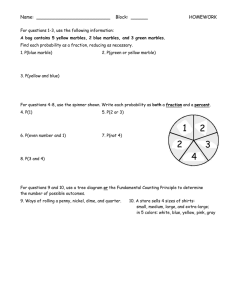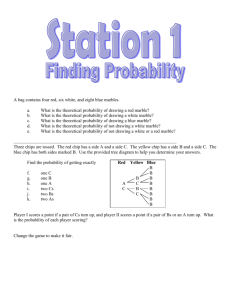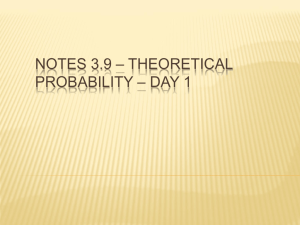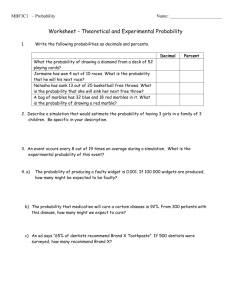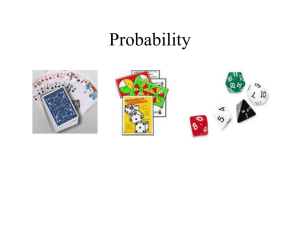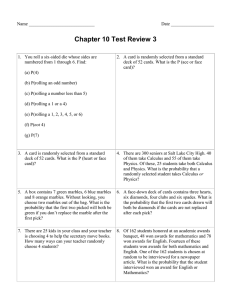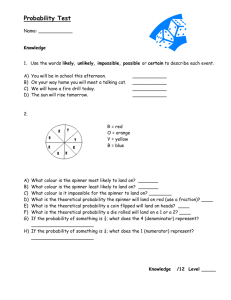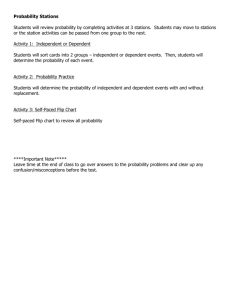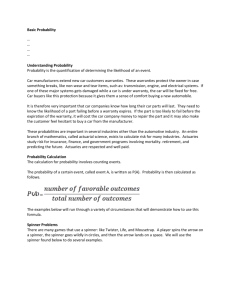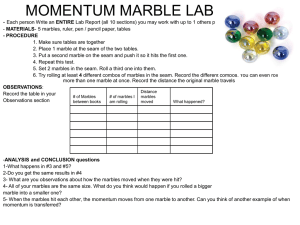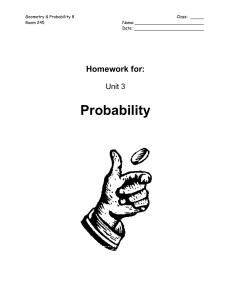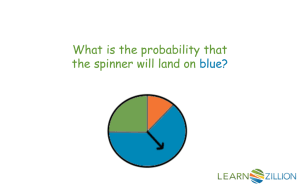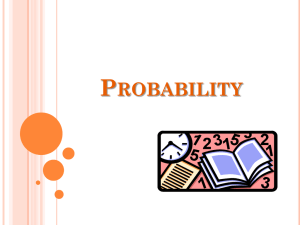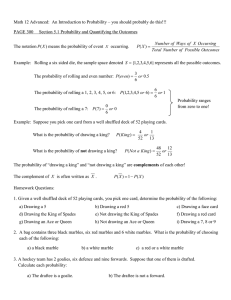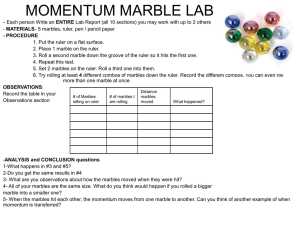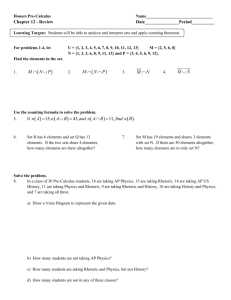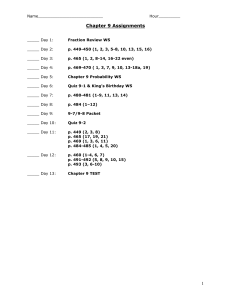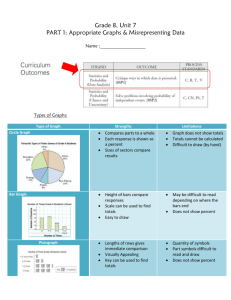Experimental vs. Theoretical Probability
advertisement
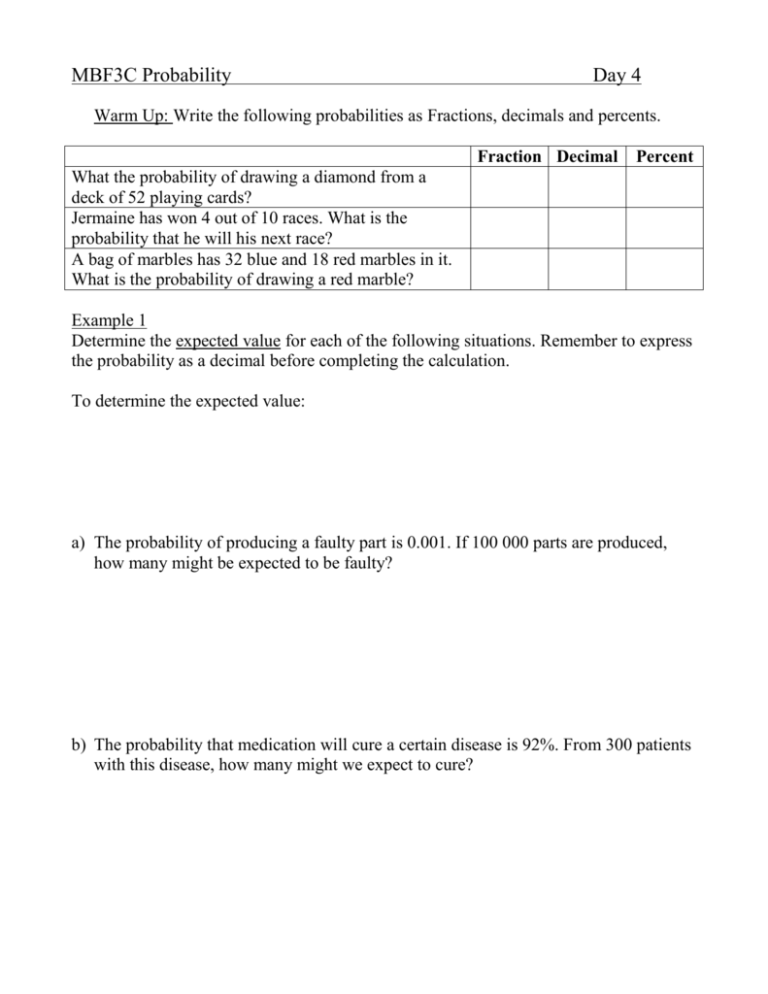
MBF3C Probability Day 4 Warm Up: Write the following probabilities as Fractions, decimals and percents. Fraction Decimal Percent What the probability of drawing a diamond from a deck of 52 playing cards? Jermaine has won 4 out of 10 races. What is the probability that he will his next race? A bag of marbles has 32 blue and 18 red marbles in it. What is the probability of drawing a red marble? Example 1 Determine the expected value for each of the following situations. Remember to express the probability as a decimal before completing the calculation. To determine the expected value: a) The probability of producing a faulty part is 0.001. If 100 000 parts are produced, how many might be expected to be faulty? b) The probability that medication will cure a certain disease is 92%. From 300 patients with this disease, how many might we expect to cure? Example 2 a) How many times would you expect the spinner to land on the 3 in 200 spins? 8 6 11 3 7 8 10 5 4 b) Mori plays a game with this spinner. He wins a dollar if the spinner lands on a prime number and he loses a dollar if the spinner lands on an even number. Is this a fair game? Explain. Example 3 Theoretical vs. Experimental Probability In a bag, there are 15 blue marbles and 10 red marbles. A marble is removed, the colour is recored and then it is put back into the bag. a) Use the frequency table below to draw a frequency distribution graph. Result Frequency Blue 12 Red 18 b) State the theoretical probability of drawing a blue marble. c) Sate the experimental probability of drawing a blue marble. d) If the experiment were repeated for another 100 trials, how would you expect the experimental probability of drawing a blue marble to change? Day 4 Practice Page 82 #1-5, 6c Page 89 #2,3,5,6 Page 94 #6,7,10 1. A survey was conducted of voting intentions in a local election. In the survey, 1000 people were asked which political party they intended to vote for. Their responses are shown in the table. Conservative 320 Liberal 420 NDP 180 Other 80 a. What is the probability that a voter in the riding will vote NDP? b. If there are 75 000 ballots cast in the election, how many people would likely vote for the NDP? 2. Slug Fest has a batting average of 0.250. If he bats 4 times in today’s game, about how many hits would you expect him to get? 3. The faces on a number cube are numbered 1, 1, 2, 3, 4, 4. Sandy played a game with this cube. She won a dollar if she rolled a 2 or 3, but had to pay a dollar if she rolled a 1 or 4. Is this a fair game? Explain. Use some calculations to back up your explanation. 4. A lottery advertises a 1 in 12 chance of winning a cash prize. If 25 000 tickets were sold, how many cash prizes are given out? 5. A die is tossed 20 times and it comes up as a three six times. a. What is the theoretical probability of tossing a three? b. What is the experimental probability of tossing a three? Worksheet Answers: 1. a. 9/50 b.13,500 2. 1 3. Not a fair game. She is twice as likely to have to pay a dollar than to gain a dollar. 4. 2083 5. A. 1/6 b. 3/10 1. In rolling a die, the theoretical possibility of rolling an odd number a) State the theoretical probability of rolling an odd number with a die. b) Roll a die 50 times. Complete the frequency chart. Result Tally Frequency Even Number Odd Number c) Calculate the experimental probability of an odd number based on the above results. d) How does the experimental probability of your die rolling results compare to the theoretical probability of rolling an odd number?
